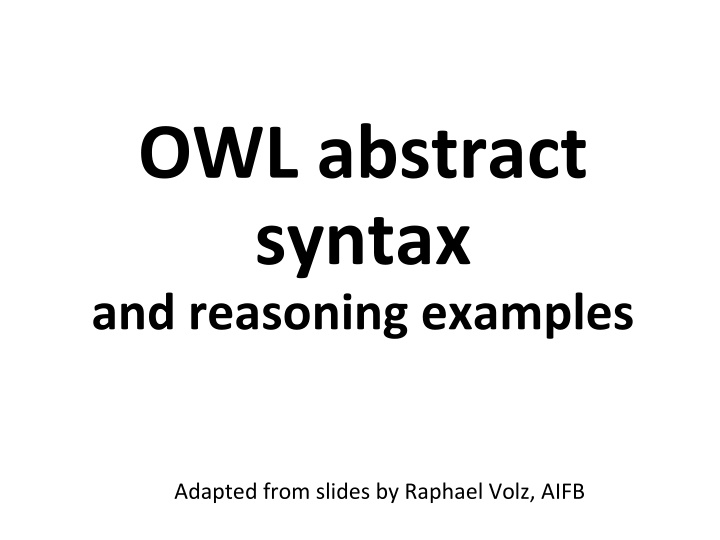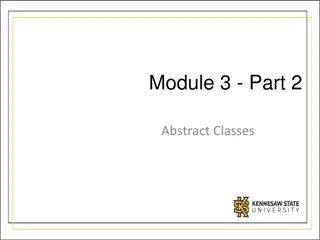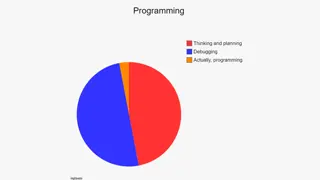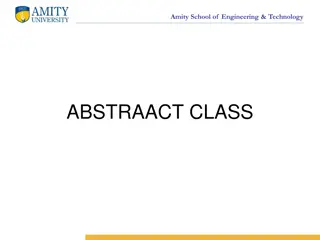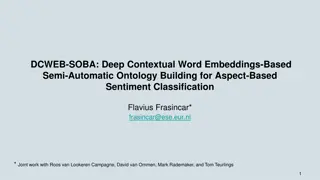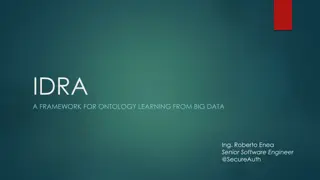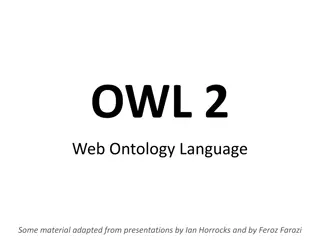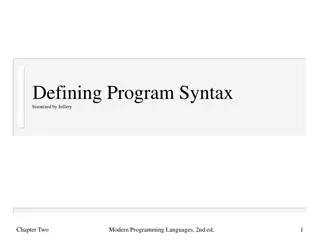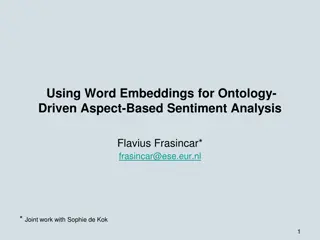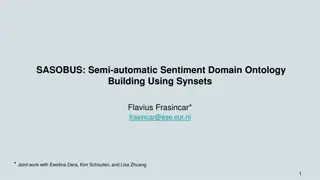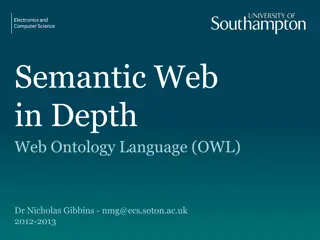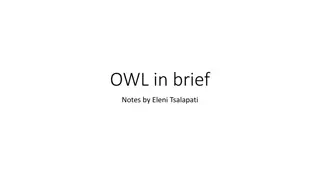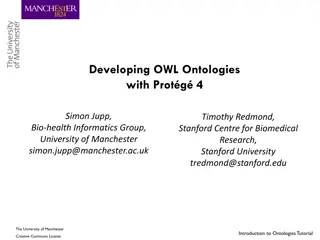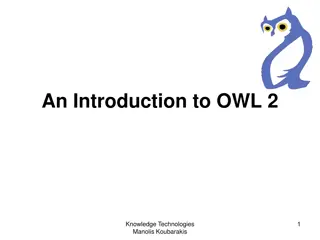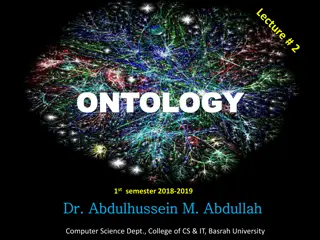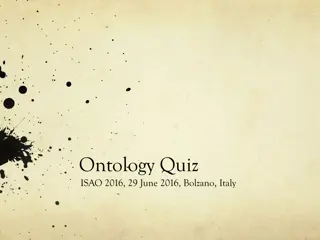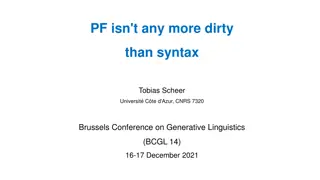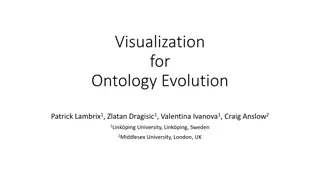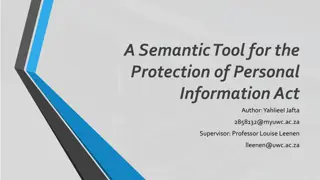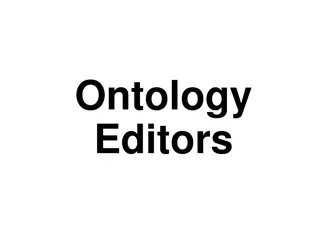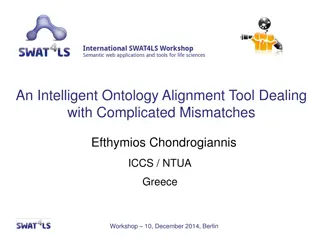OWL Abstract Syntax and Reasoning in Ontology Language
Delve into the realm of OWL abstract syntax, semantics, and reasoning examples as introduced by Raphael Volz from AIFB. Explore the use of namespaces, partial and complete definitions, and the distinctions between definitions and assertions in ontology language.
Download Presentation

Please find below an Image/Link to download the presentation.
The content on the website is provided AS IS for your information and personal use only. It may not be sold, licensed, or shared on other websites without obtaining consent from the author.If you encounter any issues during the download, it is possible that the publisher has removed the file from their server.
You are allowed to download the files provided on this website for personal or commercial use, subject to the condition that they are used lawfully. All files are the property of their respective owners.
The content on the website is provided AS IS for your information and personal use only. It may not be sold, licensed, or shared on other websites without obtaining consent from the author.
E N D
Presentation Transcript
OWL abstract syntax and reasoning examples Adapted from slides by Raphael Volz, AIFB
OWL Abstract Syntax Introduced in OWL Web Ontology Language Semantics and Abstract Syntax Useful notation, see here for examples Uses a kind of functional notation, e.g. Class(pp:duck partial pp:animal) ObjectProperty(pp:has_pet domain(pp:person) range(pp:animal)) Individual(pp:Walt value(pp:has_pet pp:Huey) value(pp:has_pet pp:Louie) value(pp:has_pet pp:Dewey))
Namespaces Namespace(pp = <http://cohse.semanticweb.org/ontologies/people#> )
Partial and complete definitions Description logics reason with definitions They prefer to have complete descriptions A complete definition includes both necessary conditions and sufficient conditions Often impractical or impossible, e.g. natural kinds Primitive definition is partial or incomplete Limits classification that can be done automatically Example: Primitive: a Person Defined: Parent = Person with at least one child
Partial and complete definitions in Owl Partial definitions typically made using one or more rdfs:subClassOf relations :Parent rdfs:subClassOf :Person Knowing that john is a parent, it is necessary that he is a person Complete definitions are made with owl:equivalentClass :Parent owl:equivalentClass [a owl:intersection (:Person [owl:restriction ])] Knowing that john is a person and has a child is sufficient to conclude he is a parent
Definition vs. Assertion Definitions describe intrinsic properties of objects. Description parts have meaning as a part of a composite description of an object Assertions describe incidental properties of objects. Asserted facts have meaning on their own. Example: a black telephone Could be either a description or an assertion, depending on the meaning and import of blackness on the concept telephone
Definition vs. Assertion In English, a black telephone is ambiguous (1) A black telephone is a common sight in an office (2) A black telephone is on the corner of my desk KR languages should not be ambiguous, so distinguish between descriptions of classes and descriptions of individuals KR languages often allow additional assertions to be made that are not part of the definition (In OWL called annotation properties)
Classification is very useful Classification is a powerful kind of reasoning that is very useful Many expert systems can be usefully thought of as doing heuristic classification Logical classification over structured descriptions and individuals is also quite useful. But can classification ever deduce something about an individual other than what classes it belongs to? And what does that tell us?
Incidental properties If we allow incidental properties (e.g., ones that don t participate in the description mechanism) then these can be deduced via classification The purpose of OWL s annotationProperty An annotationProperty can be associated with a definition (partial or complete) It is not checked when reasoning about subsumption or instance checking
Declaring classes in OWL Naming a new class plant : Class(pp:plant partial) Naming some special plants : Class(pp:grass partial pp:plant) Class(pp:tree partial pp:plant) Alternative Declaration: Class(pp:grass partial) Class(pp:tree partial) SubClassOf(pp:grass pp:plant) SubClassOf(pp:tree pp:plant)
Declaring Properties in OWL: I A simple property: ObjectProperty(pp:eaten_by) Properties may be inverse to each other: ObjectProperty(pp:eats inverseOf(pp:eaten_by)) Domain and Ranges: ObjectProperty(pp:has_pet domain(pp:person) range(pp:animal))
Declaring Properties in OWL: II Datatype Properties: DataProperty(pp:service_number range(xsd:integer)) Property Hierarchy: SubPropertyOf(pp:has_pet pp:likes) Algebraic properties: ObjectProperty(pp:married_to Symmetric) ObjectProperty(pp:ancestor_of Transitive) ObjectProperty(pp:passport_nr Functional)
Individuals in OWL Individual(pp:Tom type(owl:Person)) Individual(pp:Dewey type(pp:duck)) Individual(pp:Rex type(pp:dog) value(pp:is_pet_of pp:Mick)) Individual(pp:Mick type(pp:male) value(pp:reads pp:NYPost) value(pp:drives pp:Fiat_500) value(pp:name "Mick" xsd:string))
Entailment Quiz What follows from these descriptions?
Quiz # 1 Class(pp:old+lady complete intersectionOf(pp:elderly pp:female pp:person)) Class(pp:old+lady partial intersectionOf( restriction(pp:has_pet allValuesFrom(pp:cat)) restriction(pp:has_pet someValuesFrom(pp:animal))))
Quiz #1 - Solution Every old lady must have a pet cat. (Because she must have some pet and all her pets must be cats.)
Quiz #2 Class(pp:cow partial pp:vegetarian) Class(pp:mad+cow complete intersectionOf(pp:cow restriction(pp:eats someValuesFrom(intersectionOf(pp:brain restriction(pp:part_of someValuesFrom pp:sheep)))))) What can be said about mad cows ?
Quiz # 2 - Solution There can be no mad cows. (Because cows, as vegetarians, don t eat anything that is a part of an animal.)
Quiz #3 What are Minnie and Tom ? ObjectProperty(pp:has_pet domain(pp:person) range(pp:animal)) Class(pp:old+lady complete intersectionOf(pp:elderly pp:female pp:person)) Class(pp:old+lady partial intersectionOf(restriction(pp:has_pet allValuesFrom(pp:cat)) restriction(pp:has_pet someValuesFrom(pp:animal)))) Individual(pp:Minnie type(pp:elderly) type(pp:female) value(pp:has_pet pp:Tom))
Quiz #3 - Solution Minnie must be a person (because pet owners are human) and thus is an old lady. Thus Tom must be a cat (because all pets of old ladies are cats).
Quiz #4 Class(pp:animal+lover complete intersectionOf(pp:person restriction(pp:has_pet minCardinality(3)))) Individual(pp:Walt type(pp:person) value(pp:has_pet pp:Huey) value(pp:has_pet pp:Louie) value(pp:has_pet pp:Dewey)) DifferentIndividuals(pp:Huey pp:Louie pp:Dewey) What is Walt ?
Quiz #4 - Solution Walt must be an animal lover. Note that stating that Walt is a person is redundant.
Quiz #5 What are Mick and the National_ Enquirer ? Class(pp:van partial pp:vehicle) Class(pp:driver partial pp:adult) Class(pp:driver complete intersectionOf(restriction(pp:drives someValuesFrom(pp:vehicle)) pp:person)) Class(pp:white+van+man complete intersectionOf(pp:man restriction(pp:drives someValuesFrom(intersectionOf(pp:white+thing pp:van))))) Class(pp:white+van+man partial restriction(pp:reads allValuesFrom pp:tabloid)) Individual(pp:Q123+ABC type(pp:white+thing) type(pp:van)) Individual(pp:Mick type(pp:male) value(pp:reads pp:National_Enquirer) value(pp:drives pp:Q123+ABC))
Quiz #5 - Solution Mick drives a white van, so he must be an adult (because all drivers are adults). As Mick is male, thus he is a white van man, so any paper he reads must be a tabloid, thus the National Enquirer is a tabloid.
